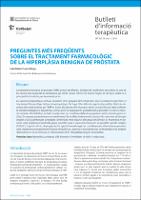Preguntes més freqüents sobre el tractament farmacològic de la hiperplàsia benigna de pròstata
Abstract
The Benign prostatic hyperplasia (BPH) is a benign proliferative process of the prostate gland and it’s one of the most frequent causes of lower urinary tract symptoms in men over 40 years of age. Age is the main risk factor to develop it. The current therapeutic options depending on the severity of the symptoms are expectant behaviour, pharmacological treatment and surgical treatment. Although there are different agents available, the absolute effectiveness of the drugs for HBP is low. Alpha-blocking agents have speed of action and improve symptomatology and urinary flow rate; but it don’t reduce the size of the prostate neither prevent urinary retention. 5-alpha-reductase inhibitors are chosen to patients with large prostates (> 30 g). In these patients they have been shown to decrease the incidence of urinary retention and the need for surgery after prolonged use. The combination therapy between these two groups of drugs is recommended in patients with moderate-severe symptoms, large prostate or prostate-specific antigen (PSA) levels of 1.5 ng / ml and high risk of progression. Anticholinergic agents are considered an alternative in patients with mainly irritating symptoms (frequency, urgency or incontinence). Phytotherapy and alternative therapies aren’t recommended in the treatment of benign prostatic hyperplasia.
Keywords
Hyperplasia; Prostate; Alpha-blockers and 5-alpha-reductase inhibitorsBibliographic citation
Robert L, Diego L. Preguntes més freqüents sobre el tractament farmacològic de la hiperplàsia benigna de pròstata. BIT. 2018 Feb;29(1):1-6.
Audience
Professionals
This item appears in following collections
- DS - Articles científics [407]
The following license files are associated with this item:

 Private area
Private area Contact Us
Contact Us







